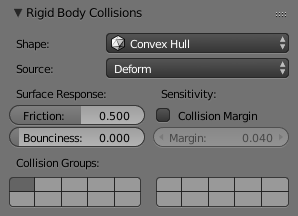Va Đập (Collisions)¶
Tham Chiếu (Reference)
- Panel (Bảng):
- Hình Dạng (Shape)
Determines the collision shape of the object; these can be broken into two categories: primitive shapes and mesh based shapes.
Primitive shapes (Box, Sphere, Capsule, Cylinder, and Cone) are best in terms of memory and performance but do not necessarily reflect the actual shape of the object. They are calculated based on the object's bounding box. The center of gravity is always in the geometric center of the shape. Primitive shapes can be shown in the 3D Viewport by enabling Bounds.
Mesh based shapes (Convex Hull and Mesh) are calculated based on the geometry of the object so they are a better representation of the object. The center of gravity for these shapes is the object origin.
- Hình Hộp (Box):
Box-like shapes (e.g. cubes), including planes (e.g. ground planes). The size per axis is calculated from the bounding box.
- Hình Cầu (Sphere):
Sphere-like shapes. The radius is the largest axis of the bounding box.
- Vỏ Nhộng (Capsule):
This points up the Z axis.
- Hình Trụ (Cylinder):
This points up the Z axis. The height is taken from the Z axis, while the radius is the larger of the X or Y axes.
- Hình Nón (Cone):
This points up the Z axis. The height is taken from the Z axis, while the radius is the larger of the X or Y axes.
- Bao Lồi (Convex Hull):
A mesh-like surface encompassing (e.g. shrink-wrapped over) all vertices (best results with fewer vertices). A convex approximation of the object, which has good performance and stability.
- Mesh [Khung Lưới]:
Mesh consisting of triangles only, allowing for more detailed interactions than convex hulls. Allows simulating concave objects, but is rather slow and unstable.
- Phụ Huynh Phức Hợp (Compound Parent):
Takes the collision shapes from the object's children and combines them. This makes it possible to create concave shapes from primitive shapes. This usually results in a faster simulation than the Mesh collision shape while also being generally more stable.
- Nguồn (Source)
Source of the mesh used to create the collision shape.
- Cơ Sở (Base):
The base mesh of the object.
- Biến Dạng (Deform):
Includes any deformations added to the mesh (shape keys, deform modifiers).
- Kết Thúc (Final):
Includes all deformations and modifiers.
- Biến Dạng (Deforming)
Mesh shapes can deform during simulation.
Phản Ứng của Bề Mặt (Surface Response)¶
- Ma Sát (Friction)
Resistance of object to movement. Specifies how much velocity is lost when objects collide with each other.
- Tính Bật Nẩy (Bounciness)
Tendency of object to bounce after colliding with another (0 to 1) (rigid to perfectly elastic). Specifies how much objects can bounce after collisions.
Độ Mẫn Cảm (Sensitivity)¶
The collision margin is used to improve the performance and stability of rigid bodies. Depending on the shape, it behaves differently: some shapes embed it, while others have a visible gap around them.
The margin is embedded for these shapes:
Hình Cầu (Sphere)
Hình Hộp (Box)
Vỏ Nhộng (Capsule)
Hình Trụ (Cylinder)
Convex Hull: Only allows for uniform scale when embedded.
The margin is "không được nhúng sẵn" for these shapes:
Hình Nón (Cone)
Khung Lưới Tam Giác Năng Động
Passive Triangle Mesh: Can be set to 0 most of the time.
- Lề (Margin)
Threshold of distance near the surface where collisions are still considered (best results when nonzero).
Bộ Sưu Tập (Collections)¶
Allows rigid body collisions allocate on different groups (maximum 20).
